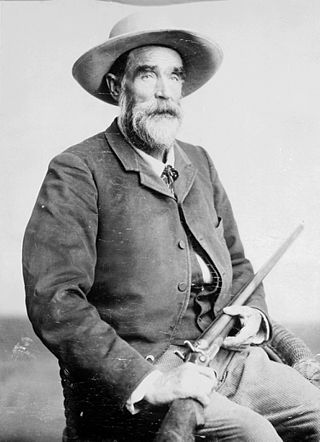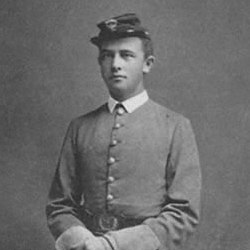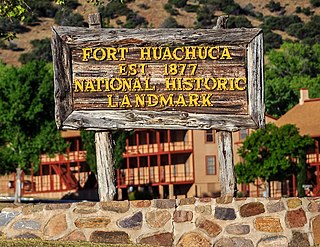
Gerónimo was a military leader and medicine man from the Bedonkohe band of the Ndendahe Apache people. From 1850 to 1886, Geronimo joined with members of three other Central Apache bands – the Tchihende, the Tsokanende and the Nednhi – to carry out numerous raids, as well as fight against Mexican and U.S. military campaigns in the northern Mexico states of Chihuahua and Sonora and in the southwestern American territories of New Mexico and Arizona.

Cochise was the Mexican leader of the Chiricahui local group of the Chokonen and principal nantan of the Chokonen band of a Chiricahua Apache. A key war leader during the Apache Wars, he led an uprising that began in 1861 and persisted until a peace treaty was negotiated in 1872. Cochise County is named after him.

George R. Crook was a career United States Army officer who served in the American Civil War and the Indian Wars. He is best known for commanding U.S. forces in the 1886 campaign that led to the defeat of the Apache leader Geronimo. As a result, the Apache nicknamed Crook Nantan Lupan, which means "Grey Wolf."

Thomas Horn Jr., was an American scout, cowboy, soldier, range detective, and Pinkerton agent in the 19th-century and early 20th-century American Old West. Believed to have committed 17 killings as a hired gunman throughout the West, Horn was convicted in 1902 of the murder of 14-year-old Willie Nickell near Iron Mountain, Wyoming. Willie was the son of sheep rancher Kels Nickell, who had been involved in a range feud with neighbor and cattle rancher Jim Miller. On the day before his 43rd birthday, Horn was executed by hanging in Cheyenne, Wyoming.

The Apache Wars were a series of armed conflicts between the United States Army and various Apache tribal confederations fought in the southwest between 1849 and 1886, though minor hostilities continued until as late as 1924. After the Mexican–American War in 1846, the United States annexed conflicted territory from Mexico which was the home of both settlers and Apache tribes. Conflicts continued as American settlers came into traditional Apache lands to raise livestock and crops and to mine minerals.

Emmet Crawford was an American soldier who rose through the ranks to become an officer. He was most noted for his time spent in the Arizona Territory under General George Crook in the United States Cavalry. He was killed in pursuit of the Apache leader Geronimo in January 1886 in Mexico.

Thomas Jefferson Jeffords was a United States Army scout, Indian agent, prospector, and superintendent of overland mail in the Arizona Territory. His friendship with Apache leader Cochise was instrumental in ending the Indian wars in that region. He first met Cochise when he rode alone into Cochise's camp in 1871 to request that the chief come to Canada Alamosa for peace talks. Cochise declined at least in part because he was afraid to travel with his family after the recent Camp Grant Massacre. Three months later he made the trip and stayed for over six months during which time their friendship grew while the negotiations failed. Cochise was unwilling to accept the Tularosa Valley as his reservation and home. In October 1872, Jeffords led General Oliver O. Howard to Cochise's Stronghold, believed to be China Meadow, in the Dragoon Mountains. Cochise demanded and got the Dragoon and Chiricahua Mountains as his reservation and Tom Jeffords as his agent. From 1872 to 1876, there was peace in southern Arizona. Then renegade Apaches killed Nicholas Rogers who had sold them whiskey and the cry went out to abolish the reservation and remove Jeffords as agent. Tom Jeffords embarked on a series of ventures as sutler and postmaster at Fort Huachuca, head of the first Tucson water company trying to bring artesian water to that city, and as prospector and mine owner and developer. He died at Owl Head Buttes in the Tortolita Mountains 35 miles north of Tucson.

The Apache Scouts were part of the United States Army Indian Scouts. Most of their service was during the Apache Wars, between 1849 and 1886, though the last scout retired in 1947. The Apache scouts were the eyes and ears of the United States military and sometimes the cultural translators for the various Apache bands and the Americans. Apache scouts also served in the Navajo War, the Yavapai War, the Mexican Border War and they saw stateside duty during World War II. There has been a great deal written about Apache scouts, both as part of United States Army reports from the field and more colorful accounts written after the events by non-Apaches in newspapers and books. Men such as Al Sieber and Tom Horn were sometimes the commanding officers of small groups of Apache Scouts. As was the custom in the United States military, scouts were generally enlisted with Anglo nicknames or single names. Many Apache Scouts received citations for bravery.

Al Sieber was a German-American immigrant who fought in the American Civil War (1861-1865), and in the American Old West frontier against the Native Americans. (Indians) in the later American Indian Wars of the mid to late 19th century. He became a prospector and later served as a decorated Chief of Scouts for the United States Army dring the subsequent Apache Wars of 1849 - 1886 in the southwestern United States.

Mr. Horn is a 1979 American Western miniseries based on Tom Horn's writings, starring David Carradine. It was directed by Jack Starrett from a screenplay by William Goldman. This version came out just prior to the 1980 feature film Tom Horn, which starred Steve McQueen.
Sahuaripa is a town in the Mexican state of Sonora, municipality of Sahuaripa. The area is 5,694.4 km². with a population of 5,792 in 2005. The town and municipal seat had a population of 3,807 in 2000.

Matthias W. Day was a career American army officer who received the Medal of Honor, the United States' highest military decoration, for his actions during the American Indian Wars in the latter half of the 19th century. Day was a longtime officer with the African-American 9th Cavalry Regiment, seeing action during the Apache Wars against the Apache leaders Victorio and Geronimo.

Marion Perry Maus was a United States Army brigadier general who was a recipient of the Medal of Honor for valor in action on January 11, 1886, in the Sierra Madre Mountains, Mexico. An 1874 graduate of West Point, he served in three wars and in multiple commands in the Army during his long career, retiring in 1913.

The Battle of Big Dry Wash was fought on July 17, 1882, between troops of the United States Army's 3rd Cavalry Regiment and 6th Cavalry Regiment and warriors of the White Mountain Apache tribe.The location of the battle was called "Big Dry Wash" in Major Evans' official report, but later maps called the location "Big Dry Fork", which is how it is cited in the four Medal of Honor citations that resulted from the battle.

First Lieutenant Charles Bare Gatewood was an American soldier born in Woodstock, Virginia. He was raised in Harrisonburg, Virginia, where his father ran a press. He served in the United States Army in the 6th Cavalry after graduating from West Point. Upon assignment to the American Southwest, Gatewood led platoons of Apache and Navajo scouts against renegades during the Apache Wars. In 1886, he played a key role in ending the Geronimo Campaign by persuading Geronimo to surrender to the army. Beset with health problems due to exposure in the Southwest and Dakotas, Gatewood was critically injured in the Johnson County War and retired from the Army in 1895, dying a year later from stomach cancer. Before his retirement he was nominated for the Medal of Honor, but was denied the award. He was portrayed by Jason Patric in the 1993 film Geronimo: An American Legend.

The White massacre was an engagement between American settlers and a band of Utes and Jicarilla Apaches that occurred in northeastern New Mexico on October 28, 1849. It became notable for the Indians' kidnapping of Mrs. Ann White, who was subsequently killed during an Army rescue attempt a few weeks later.
The Battle of Devil's Creek was a military engagement during Geronimo's War, fought on May 22, 1885 near Alma, New Mexico. Though it was a minor skirmish, it was the first battle of the Geronimo campaign and ended after the Apaches were routed from their positions.

The Apache Campaign of 1896 was the final United States Army operation against Apaches who were raiding and not living in a reservation. It began in April after Apache raiders killed three white American settlers in the Arizona Territory. The Apaches were pursued by the army, which caught up with them in the Four Corners region of Arizona, New Mexico, Sonora and Chihuahua. There were only two important encounters during the campaign and, because both of them occurred in the remote Four Corners region, it is unknown if they took place on American or Mexican soil.
First Lieutenant Britton Davis was an American soldier born in Brownsville, Texas. He served in the United States Army in the 6th Cavalry after graduating from West Point in 1881. After serving at Fort D.A. Russell, Davis was transferred to the Southwest to serve at San Carlos in 1882 during the Apache Wars where he commanded two companies of Apache Scouts alongside Captain Emmet Crawford. In 1886, he played a key role in ending the Geronimo Campaign.

This is a list with images of some of the historic structures and places in the Fort Huachuca National Historic District in Arizona. The district, also known as Old Fort Huachuca, is located within Fort Huachuca an active United States Army installation under the command of the United States Army Installation Management Command. The fort sits at the base of the Huachuca Mountains four miles west of the town of Sierra Vista, on AZ 90 in Cochise County, Arizona.



















